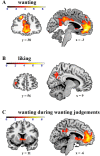Opioid antagonism modulates wanting-related frontostriatal connectivity
- PMID: 34761749
- PMCID: PMC8598157
- DOI: 10.7554/eLife.71077
Opioid antagonism modulates wanting-related frontostriatal connectivity
Abstract
Theoretical accounts distinguish between motivational ('wanting') and hedonic ('liking') dimensions of rewards. Previous animal and human research linked wanting and liking to anatomically and neurochemically distinct brain mechanisms, but it remains unknown how the different brain regions and neurotransmitter systems interact in processing distinct reward dimensions. Here, we assessed how pharmacological manipulations of opioid and dopamine receptor activation modulate the neural processing of wanting and liking in humans in a randomized, placebo-controlled, double-blind clinical trial. Reducing opioid receptor activation with naltrexone selectively reduced wanting of rewards, which on a neural level was reflected by stronger coupling between dorsolateral prefrontal cortex and the striatum under naltrexone compared with placebo. In contrast, reducing dopaminergic neurotransmission with amisulpride revealed no robust effects on behavior or neural activity. Our findings thus provide insights into how opioid receptors mediate neural connectivity related to specifically motivational, not hedonic, aspects of rewards.
Trial registration: ClinicalTrials.gov NCT02557984.
Keywords: dopamine; human; liking; neuroscience; opioid; reward; striatum; wanting.
© 2021, Soutschek et al.
Conflict of interest statement
AS, SW, BQ, PT No competing interests declared, TK Reviewing editor, eLife
Figures



Similar articles
-
Effects of dopamine and opioid receptor antagonism on the neural processing of social and nonsocial rewards.Hum Brain Mapp. 2024 Mar;45(4):e26645. doi: 10.1002/hbm.26645. Hum Brain Mapp. 2024. PMID: 38445523 Free PMC article. Clinical Trial.
-
Opioid reward 'liking' and 'wanting' in the nucleus accumbens.Physiol Behav. 2008 Aug 6;94(5):675-80. doi: 10.1016/j.physbeh.2008.04.006. Epub 2008 Apr 13. Physiol Behav. 2008. PMID: 18513761 Review.
-
'Liking' and 'wanting' in eating and food reward: Brain mechanisms and clinical implications.Physiol Behav. 2020 Dec 1;227:113152. doi: 10.1016/j.physbeh.2020.113152. Epub 2020 Aug 23. Physiol Behav. 2020. PMID: 32846152 Free PMC article. Review.
-
Dopaminergic and opioidergic regulation during anticipation and consumption of social and nonsocial rewards.Elife. 2020 Oct 13;9:e55797. doi: 10.7554/eLife.55797. Elife. 2020. PMID: 33046213 Free PMC article.
-
Dopamine D2/3- and μ-opioid receptor antagonists reduce cue-induced responding and reward impulsivity in humans.Transl Psychiatry. 2016 Jul 5;6(7):e850. doi: 10.1038/tp.2016.113. Transl Psychiatry. 2016. PMID: 27378550 Free PMC article. Clinical Trial.
Cited by
-
Naltrexone dose-selectively modulates goal-directed behavior and the hypothalamic proteome in rats.Pharmacol Rep. 2025 Aug;77(4):983-998. doi: 10.1007/s43440-025-00735-4. Epub 2025 May 28. Pharmacol Rep. 2025. PMID: 40434617 Free PMC article.
-
Abnormal functional connectivity of the nucleus accumbens subregions mediates the association between anhedonia and major depressive disorder.BMC Psychiatry. 2023 Apr 21;23(1):282. doi: 10.1186/s12888-023-04693-0. BMC Psychiatry. 2023. PMID: 37085792 Free PMC article.
-
Antagonists of the stress and opioid systems restore the functional connectivity of the prefrontal cortex during alcohol withdrawal through divergent mechanisms.bioRxiv [Preprint]. 2024 Jan 14:2023.09.30.560339. doi: 10.1101/2023.09.30.560339. bioRxiv. 2024. PMID: 37873478 Free PMC article. Preprint.
-
Striatal resting-state connectivity after long-term diacetylmorphine treatment in opioid-dependent patients.Brain Commun. 2022 Oct 26;4(6):fcac275. doi: 10.1093/braincomms/fcac275. eCollection 2022. Brain Commun. 2022. PMID: 36382218 Free PMC article.
-
Effects of dopamine D2/3 and opioid receptor antagonism on the trade-off between model-based and model-free behaviour in healthy volunteers.Elife. 2022 Dec 5;11:e79661. doi: 10.7554/eLife.79661. Elife. 2022. PMID: 36468832 Free PMC article.
References
Publication types
MeSH terms
Substances
Associated data
LinkOut - more resources
Full Text Sources
Medical

